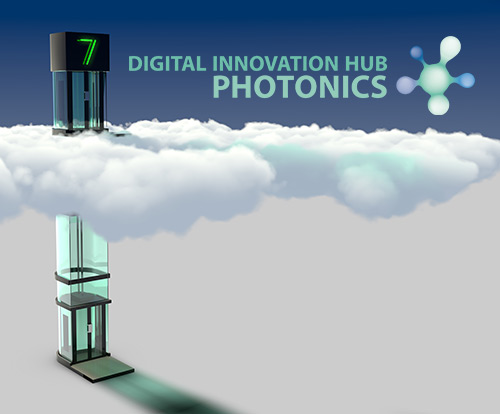Innovative start-up and research ideas honored at “Digital Pitch 2021”
Latest technologies for early diagnosis of cancer and Alzheimer's disease, quantum imaging for biomedicine and contactless fingerprinting: At this year's “Digital Pitch” of the Jena-based “Digital Innovation Hub Photonics”, innovative research and start-up projects from the photonics industry were honored once again. The winning teams will receive funding of 120,000 euros in total from the Thuringian Ministry of Economics, Science and Digital Society.

The “Digital Innovation Hub Photonics” (DIHP) is a project that supports spin-offs and start-ups in the field of optics and photonics. Its goal is to support new business ideas and young research in the field of optics and photonics. On January 28, the “Elevator Pitch” was organized for the third time - this year for the first time completely digitally. Young researchers were invited to present the latest research ideas and business models using optics and photonics.
The winning teams received funding for their research project amounting to 50,000, 40,000 and 30,000 euros respectively, as well as professional support in developing their own business idea. There is also the possibility of concluding a cooperation agreement for strategic collaboration with research institutions at the High-Performance Center Photonics, where the DIHP is located, after the completion of successful preliminary research.
Teams from Italy, Switzerland, Berlin and Thuringia competed in the “Digital Pitch”. First place went to a start-up from Milan. Thuringian start-ups took second and third place.
The three winning teams of the “Digital Pitch 2021”
A jury assessed the presented projects on the basis of their economic usability, their relevance as a key technology and the viability of the business models. The selection committee was made up of representatives from a wide range of institutions from business and science, including companies such as Jenoptik AG, AMS Sensors Germany GmbH, Axel Springer hy GmbH and Optec-Berlin-Brandenburg (OpTecBB) e.V.
In addition, the High-Tech Gründerfonds, Gründerservice K1 of the Friedrich Schiller University Jena, Gründerservice of the Ernst Abbe University Jena and the Fraunhofer-internal technology transfer program AHEAD were represented on the jury. They selected three winning teams:
- 1st place | Spectro Srl. (Milan, Italy): “On-chip spectroscopy"
Dr. Giuseppe Antonacci, Prof. Dario Poli, Riccardo Magno (specto photonics Srl.)
When the human body falls ill with, for example, cancer or atherosclerosis, the biomechanical properties of the cells affected by the pathogen change. When examining these cells with current analytical techniques, it often requires invasive procedures. Brillouin spectroscopy, in contrast, takes a new approach: it uses a beam of light that makes it possible to optically retrieve mechanical and viscoelastic information from organic and inorganic materials - without any physical contact.
Against this background, the Italian start-up Specto Srl. presented at the “Digital Pitch” a miniature device for Brillouin spectroscopy that forgoes all mechanical components and replaces them with a single, miniaturized silicon photonic chip. As a result, light no longer travels through lenses but through the ultra-small printed circuits on the chip. Their device is not only faster and more accurate at capturing data. It is also smaller and therefore portable, as well as easier to use and less expensive. The device will be used for early diagnosis of atherosclerosis, cancer, keratoconus, meningitis, Alzheimer's disease and amyotrophic lateral sclerosis.
- 2nd place | Quantum Optics Jena GmbH: “QuSense” sensor technology
Dr. Dr. Kevin Füchsel and Dr. Oliver de Vries (Fraunhofer IOF)
By decoupling the illumination wavelength for an object which is supposed to be analyzed (e.g., a biological sample) from the wavelength for sensor detection (e.g., on a microscope), quantum-based methods for imaging will revolutionize classical imaging systems. Potential applications include primarily the field of microscopy and thus biomedicine. But there are also market opportunities in the automotive industry, in quality control or in materials science. An essential component of this technology is a nonlinear interferometer equipped with a photon pair source. Reducing a nonlinear interferometer to such an extent that it can be used as a “plug & play” system on commercially available scanning microscopes is the goal of the “QuSense” sensor technology which is developed by Quantum Optics Jena GmbH.
- 3rd place | IDLoop (Jena): Contactless fingerprint measurement
Jörg Reinhold and Dr. Tom Michalsky (IDLoop)
Cataloging fingerprints is becoming more and more important, especially in government agencies. Their recording should be fast, robust and intuitive - and since Covid-19, above all, hygienic. The Jena-based start-up IDLoop has developed a concept for this purpose that captures the ridges of a finger using optical 3D measurement technology in the micrometer range. The goal is to achieve unprecedented image quality at manufacturing costs that can compete with existing contactless systems. The complete 3D scanning of the finger’s ridges makes this system unique and allows full regulatory certification for the first time. In conjunction with “roll-off” algorithms, contactless captured fingerprint images are also compatible with existing databases. In addition, the utilization of 3D fingerprint images for police or forensic applications is possible.